Assessment of correlation and path coefficient analysis for yield and it’s attributing traits in rice (Oryza sativa L.) genotypes
Bạn đang xem bản rút gọn của tài liệu. Xem và tải ngay bản đầy đủ của tài liệu tại đây (456.31 KB, 7 trang )
Int.J.Curr.Microbiol.App.Sci (2020) 9(7): 3845-3851
International Journal of Current Microbiology and Applied Sciences
ISSN: 2319-7706 Volume 9 Number 7 (2020)
Journal homepage:
Original Research Article
/>
Assessment of Correlation and Path Coefficient Analysis for Yield and it’s
Attributing Traits in Rice (Oryza sativa L.) Genotypes
Deepak Meena1, Manoj Kumar1*, Sandhya1, N. R. Koli1,
Yamini Tak2 and Ashok Kumar Meena1
1
Department of Genetics and Plant Breeding, 2Department of Biochemistry, Agriculture
University Kota, India
*Corresponding author
ABSTRACT
Keywords
Correlation and
Path Coefficient
Analysis, Rice
(Oryza sativa L.)
Article Info
Accepted:
22 June 2020
Available Online:
10 July 2020
Present investigation was carried out to examine the association and path analysis for grain
yield and its attributing traits in 25 rice genotypes. The result of character association
revealed that number of productive tillers per plant (r p 0.881 & rp 0.993) exhibited highly
significant and positive correlation with grain yield per plant followed by 1000-grains
weight (rp 0.607 & rg 0.645), panicle length (rp 0.369 & rg 0.459), plant height (rp 0.284 &
rg 0.409), days to maturity (rp 0.293 & rg 0.325) and days to 50 per cent flowering (r p 0.294
& rg 0.308) at phenotypic as well as genotypic level respectively proving that grain yield
could be enhanced by selecting genotypes containing higher values for these attributes.
The path analysis result showed that the maximum direct positive effect on the grain yield
per plant was exerted by number of productive tillers per plant followed by 1000-grain
weight, panicle length, plant height, days to maturity and days to 50 percent flowering.
These characters also exhibited prominent role as indirect effects of most component traits
on grain yield per plant hence these traits should be considered as an essential selection
criteria toward optimizing crop yield.
Introduction
Rice (Oryza sativa L.) is self-pollinated,
annual cereal crop of the Poaceae family.It
has 2n=24 chromosome number. The genus
Oryza consisted of a total of 25 recognized
species of which, 23 are wild species and two
Oryza sativa and Oryza glaberrima are
cultivated. Rice is the second most consumed
cereal crop and staple food in the world for
even more than 60 % of the global
inhabitants, delivering around 75% of calories
as well as 55% of dietary protein in their
regular normal intake. Almost 90 % of the
world’s rice is produced mostly in Asian
continent, therefore Asia is recognized as the
world's rice bowl. In India rice occupied
approximately
43.79
mha
of
area
with production of 116.42 million tones and
productivity nearly 2650 kg / ha.( Anonymous
2018-19).In Rajasthan rice cultivated on
0.199 million hectares area with the
production of 0.46million tones and
productivity of 2310 kg/ha during(
Anonymous 2018-19).Demand of rice is
steadily increasing due to unhindered
3845
Int.J.Curr.Microbiol.App.Sci (2020) 9(7): 3845-3851
population expansion. In order to cope with
the already-increasing population and selfsufficiency in rice production and perhaps to
retain price stability, new varieties that might
crack the yield ceiling are desperately
required to develop.
Yield is a complex polygenic character
largely influenced by its various component
characters as well as by the environment.
Hence, it becomes essential to estimate
association of the yield with component
characters and among themselves.
The efficiency of selection thus can be
increased, if it is simultaneously practiced for
characters which are correlated with yield. In
the quantitative traits, the genotypes are
influenced by the environment, thereby,
affecting the phenotypic expression as well as
association and consequently direction of
association between the characters. The
knowledge of magnitude and direction of
correlation is used for judging how
improvement in one character will bring
simultaneous change in the other characters.
The correlation analysis provide an
information which is incomplete in the sense
that it does not throw light on the underlying
cause that are operative for the various
interrelationship. The expression of a
complex character such as grain yield per
plant depends upon the interaction of a
number of component attributes.
A better picture of the contribution of each
component building up the total genetic
architecture of a complex character may be
obtained through the analysis of causal
schemes. Hence, in such a situation path
coefficient analysis devised by Wright (1921)
had been useful in partitioning direct and
indirect causes of association which allow a
detailed examination of specific forces acting
to produce a given correlation and measures
of the relative importance of each causal
character. Such a study provides a realistic
basis for allocation of weightage to each
attributes in deciding a suitable criterion for
genetic improvement. The analysis of
correlation coefficient along with information
on path coefficient helps considerably in
identification of suitable characters for yield
enhancement.
Materials and Methods
The experiment was carried out at Agriculture
Research Station, Kota, Rajasthan. The
experimental materials comprised of twenty
five genotypes of rice. These genotypes were
grown in a Randomized Block Design (RBD)
with three replications during Kharif 2019.
Twenty four days old seedlings were
transplanted in 10 rows of 5 m length having
plant to plant and row to row distance 20cm.
and 10 cm, respectively. All necessary
precautions were taken to maintain uniform
plant population in each treatment and in each
replication.
Observations were recorded for the characters
viz., days to 50 per cent flowering, days to
maturity, plant height, number of productive
tillers per plant, panicle length, number of
grains per panicle, 1000-grains weight,
amylose content (%), protein content (%), and
grain yield per plant. The mean values of data
was used for statistical analysis of correlation
and path coefficient as per suggested by Singh
and Chaudhary (1979) and Dewey and Lu
(1959), respectively.
Results and Discussion
The association result revealed that genotypic
correlation coefficients were higher than their
corresponding
phenotypic
correlation
coefficient which might be from the
modifying effect of environment on the
association of characters at phenotypic level
(Table.1).
3846
Int.J.Curr.Microbiol.App.Sci (2020) 9(7): 3845-3851
Table.1 Estimation of Phenotypic (P) and Genotypic (G) correlation coefficient for 10 Characters of Rice
Characters
R
Days to
50%
flowering
Days to
Maturity
Plant
height
(cm.)
0.976**
0.754**
Days to 50% P
1.000
flowering
0.999**
0.926**
G
1.000
0.767**
Days to
P
1.000
maturity
0.941**
G
1.000
Plant height P
1.000
(cm)
G
1.000
Number of
P
productive
G
tillers per
plant
Panicle
P
length (cm)
G
Number of
P
grains per
G
panicle
1000-grain
P
weight (g)
G
Amylose
P
content (%)
G
Protein
P
content (%)
G
Grain yield
P
per plant (g) G
*, ** Significant at 5% and 1% levels, respectively
Number of
productive
tillers per
plant
0.302**
0.329**
0.323**
0.348**
0.280*
0.383**
1.000
1.000
Panicle
length
(cm.)
0.585**
0.631**
0.632**
0.668**
0.567**
0.705**
0.396**
0.484**
1.000
1.000
3847
Number
of grains
per
panicle
0.694**
0.961**
0.677**
0.988**
0.526**
0.859**
0.197
0.233*
1000grain
weight
(g)
0.362**
0.372**
0.415**
0.430**
0.411**
0.534**
0.527**
0.577**
Amylose
content
(%)
Protein
content
(%)
Grain yield
per plant
(g)
-0.446**
-0.481**
-0.418**
-0.446**
-0.331**
-0.433**
0.117
0.124
-0.074
-0.089
-0.040
-0.036
-0.101
-0.133
0.214
0.210
0.294**
0.308**
0.293**
0.325**
0.284*
0.409**
0.881**
0.993**
0.375**
0.518**
1.000
1.000
0.622**
0.677**
0.262*
0.340**
0.048
0.057
-0.334**
-0.488**
0.031
0.058
0.066
0.067
0.369**
0.459**
0.146
0.204
1.000
1.000
0.284*
0.293**
1.000
1.000
0.420**
0.456**
0.384**
0.412**
1.000
1.000
0.607**
0.645**
0.139
0.157
0.178
0.185
1.000
1.000
Int.J.Curr.Microbiol.App.Sci (2020) 9(7): 3845-3851
Table.2 Estimates of genotypic and phenotypic direct and indirect effects between yield and its attributing traits
Days to
50%
flowering
Days to
maturity
Plant
height
(cm.)
Number of
productive
tillers per
plant
Panicle
length
(cm.)
Number
of grains
per
panicle
1000grain
weight
(g)
Amylose
content
(%)
Protein
content
(%)
Correlation
with grain
yield per
plant
P
0.5771
-0.5302
0.0029
0.2367
-0.0711
-0.0585
0.1273
0.0015
0.0078
0.294**
G
0.0607
0.0199
0.2224
0.3067
-0.1418
-0.1971
0.0645
-0.0319
0.0047
0.308**
P
0.5633
-0.5431
0.0030
0.2525
-0.0768
-0.0570
0.1457
0.0014
0.0041
0.293**
G
0.0606
0.0199
0.2261
0.3248
-0.1503
-0.2025
0.0745
-0.0295
0.0019
0.325**
P
0.4350
-0.4167
0.0038
0.2190
-0.0689
-0.0443
0.1443
0.0011
0.0106
0.284*
G
0.0562
0.0187
0.2402
0.3580
-0.1584
-0.1763
0.0925
-0.0287
0.0069
0.409**
Number of productive P
tillers per plant
G
0.1745
-0.1752
0.0011
0.7826
-0.0481
-0.0166
0.1851
-0.0004
-0.0224
0.881**
0.0199
0.0069
0.0921
0.9336
-0.1087
-0.0478
0.1000
0.0082
-0.0109
0.993**
Panicle length( cm)
P
0.3378
-0.3434
0.0022
0.3100
-0.1214
-0.0316
0.2183
-0.0002
-0.0033
0.369**
G
0.0383
0.0133
0.1693
0.4514
-0.2248
-0.1062
0.1173
0.0038
-0.0030
0.459**
Characters
Days to 50%
flowering
Days to maturity
Plant height( cm)
Number of grains per
panicle
P
0.4005
-0.3675
0.0020
0.1540
-0.0455
-0.0843
0.0922
0.0011
-0.0069
0.146
G
0.0583
0.0197
0.2065
0.2176
-0.1164
-0.2051
0.0590
-0.0324
-0.0035
0.204
1000-grain weight(g)
P
0.2092
-0.2252
0.0016
0.4125
-0.0755
-0.0221
0.3513
-0.0009
-0.0438
0.607**
G
0.0226
0.0086
0.1283
0.5388
-0.1523
-0.0698
0.1732
0.0195
-0.0238
0.645**
P
-0.2575
0.2272
-0.0013
0.0919
-0.0058
0.0282
0.0997
-0.0033
-0.0401
0.139
G
-0.0292
-0.0089
-0.1040
0.1158
-0.0128
0.1001
0.0508
0.0663
-0.0215
0.157
P
-0.0429
0.0215
-0.0004
0.1677
-0.0038
-0.0055
0.1474
-0.0013
-0.1044
0.178
G
-0.0054
-0.0007
-0.0320
0.1956
-0.0129
-0.0138
0.0790
0.0273
-0.0521
0.185
Amylose content( %)
Protein content( %)
Phenotypic residual effect = 0.16229, Genotypic residual effect = 0.1819
3848
Int.J.Curr.Microbiol.App.Sci (2020) 9(7): 3845-3851
Fig.1 Diagrammatical presentation of genotypic correlation coefficient
for 10 Characters in rice genotypes
Fig.2 Genotypic path diagram for grain yield per plant
3849
Int.J.Curr.Microbiol.App.Sci (2020) 9(7): 3845-3851
Grain yield per plant was positively and
significant correlated with characters viz.,
days to 50 per cent flowering, days to
maturity, plant height, number of productive
tillers per plant, panicle length and 1000-grain
weight at phenotypic and genotypic levels,
respectively indicating grain yield of rice can
be improved by selecting genotypes having
higher values for these traits. These results
were in accordance with the results of
Rajamadhan et al., (2011), Limbani et al.,
(2017), Priya et al., (2017), Sangare (2017),
Edukondalu et al., (2017), Kumar V. and
Sonali K. ( 2018).
The correlation of days to 50 per cent
flowering was positively and significantly
correlated with days to maturity, plant height,
number of productive tillers per plant, panicle
length, grains per panicle, 1000-grain weight
and grain yield per plant at both the levels
whereas days to maturity had positive and
significantly correlation with plant height,
number of productive tillers per plant, panicle
length, grains per panicle and 1000-grains
weight and grain yield per plant. Plant height
was significantly and positively correlated
with number of productive tillers per plant,
panicle length, number of grains per panicle,
1000-grain weight and grain yield per plant.
Positive and significant correlation of number
of productive tillers per plant was observed
with panicle length, 1000-grains weight,
number of grain per panicle and grain yield
per plant and at genotypic level. Panicle
length was positively and significantly
correlated with grain per panicle, 1000-grains
weight and grain yield per plant whereas
number of grains per panicle had positive and
significant correlation with 1000-grains
weight.
Positive and significant correlation of 1000grains weight was recorded with amylose
content, protein content and grain yield per
plant. Amylose content was positively and
significantly correlated with protein content.
Path coefficient analysis result (Table 2)
revealed that, maximum direct positive effect
on grain yield per plant was observed for
number of productive tillers per plant
followed by 1000-grains weight, panicle
length, plant height, days to maturity and days
to 50 per cent flowering at both the levels,
respectively.
These results are in agreement to the earlier
finding of Khare et al., (2015) Hijam et al.,
(2017), Sowjanya et al., (2017) and
Monalisha et al., (2018). The high positive
association of other characters with grain
yield per plant was also due to high indirect
effect through these characters. On the other
hand, negative direct effect on grain yield per
plant at was exhibited by panicle length,
number of grains per panicle and protein per
cent and at genotypic level whereas, at
phenotypic level negative direct effect on
grain yield per plant was exhibited by days to
maturity, panicle length, number of grains per
panicle, amylose content and protein content.
Jan et al., (2017), Monalisha et al., (2018)
reported similar findings earlier.
Among all the characters, at genotypic level
number of productive tillers per plant(
0.9336) had the maximum direct effect
followed by plant height (0.2402), 1000grains weight (0.1732), amylose content
(0.0663), days to 50 per cent flowering
(0.0607) and days to maturity (0.0199). On
the other hand, negative direct effect were
observed for panicle length (-0.2248), number
of grains per panicle (-0.2051) and protein
content (-0.0521). At phenotypic level higher
direct effect was observe for number of
productive tillers per plant (0.7826) followed
by days to 50 per cent flowering (0.5771),
days to maturity (0.5431), 1000-grain weight
(0.3513) and plant height (0.038).
3850
Int.J.Curr.Microbiol.App.Sci (2020) 9(7): 3845-3851
References
Anonymous, (2018-19). Agriculture Statistics at a
Glance, Directorate of Economics &
Statistics, Department of Agriculture &
Cooperation, Ministry of Agriculture.
Government of India.
Anonymous, (2018-19). Rajasthan Agriculture
statistics at a Glance, Commissionarate of
Agriculture, Rajasthan, Jaipur.
Dewy, D.R. and Lu, K.H.( 1959). A correlation
and path coefficient analysis of components
of crested wheat grass seed production.
Journal of Agronomy, 51: 515– 518.
Edukondalu, B., Reddy, V.R., Rani, T.S., Kumari,
C.A. and Soundharya, B. ( 2017). Studies on
Variability, Heritability, Correlation and Path
Analysis for Yield, Yield Attributes in Rice
(Oryza sativa L.). International Journal of
Current Microbiology Applied Science,
6(10): 2369-2376.
Hijam, L., Sarkar, K.K. and Mukherjee, S.(2017).
Inheritance and association of yield and its
attributing traits in rice (Oryza sativa L.).
Journal of Crop and Weed, 13(1): 64-71.
Jan, N., Lal, E.P., Kashyap, S.C. and Gaur, A.
(2017). Genetic variability, character
association and path analysis studies for
contributing traits in rice (Oryza sativa L.)
under temperate conditions of Kashmir.
Vegetos- An International Journal of Plant
Research, 30(2): 1-7.
Khare, R., Singh, A.K. and Singh, P.K. (2015).
Genetic variability association and diversity
analysis in upland rice (Oryza sativa L).
SAARC Journal of Agriculture, 12(2): 40-51.
Kumar, V. and Sonali K. (2018). Association
analysis of native rice (Oryza sativa L.) of
Bastar. Electronic Journal of Plant Breeding,
9(1): 199-212.
Limbani, P.L., Gangani, M.K. and Pandya, M.M.
(2017). Genetic Variability, heritability and
genetic advance in rice (Oryza sativa L.).
International Journal of Pure & Applied
Biosciences.5( 6): 1364-1371.
Monalisha, P. and Das, S.R. (2018). Genetic
variability, correlation and path analysis in
hybrid rice. International Journal of
Agriculture Sciences, 10(14): 6691-6693.
Priya, S., Suneetha, Y., Babu, D.R. and Rao, V.S.
(2017). Inter-relationship and path analysis
for yield and quality characters in rice (Oryza
sativa L.). International Journal of Science,
Environment and Technology, 6(1): 381-390.
Rajamadhan, R., Eswaran, R. and Anandan, A.
(2011). Investigation of correlation between
traits and path analysis of rice (Oryza sativa
L.) grain yield under coastal salinity.
Electronic Journal of Plant Breeding, 2(4):
538-542.
Sangaré, J.R., Konaté, A.K., Cissé, F. and Sanni,
A. (2017). Assessment of genetic parameters
for yield and yield related-traits in an
intraspecific rice (Oryza sativa L.)
population. Journal of Plant Breeding and
Genetics, 5(2): 45-56.
Singh, R.K. and choudhary, B.D. (1979).
Biometrical methods in quantative genetic
analysis. Kalyani Publishers. Ludhiana and
Delhi.
Sowjanya, P.R., Raghavendra, P. and Shailaja, H.
(2017). Trait association studies to determine
selection indices in two F3 segregating
populations of rice (Oryza sativa L.) under
aerobic condition. Oryza, 54(3): 276-281.
Wright, S. (1921). Correlation and causation.
Journal of Agriculture Research, 20: 257287.
How to cite this article:
Deepak Meena, Manoj Kumar, Sandhya, N. R. Koli, Yamini Tak and Ashok Kumar Meena.
2020. Assessment of Correlation and Path Coefficient Analysis for Yield and it’s Attributing
Traits in Rice (Oryza sativa L.) Genotypes. Int.J.Curr.Microbiol.App.Sci. 9(07): 3845-3851.
doi: />
3851
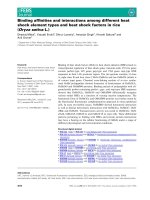
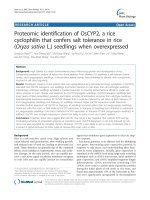
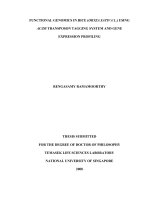
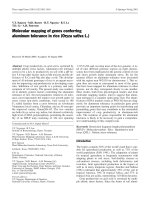
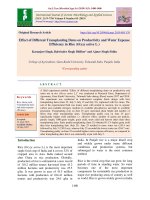
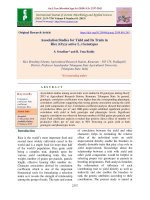

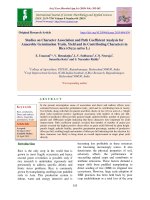
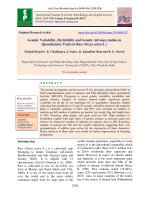
![Genetic variability studies in segre gating population (F2) of a cross, Phule utkarshi × Arka anamika for yield and its attributing traits in okra [Abelmoschus esculentus (L.) Moench]](https://media.store123doc.com/images/document/2020_03/11/medium_rhy1583901614.jpg)